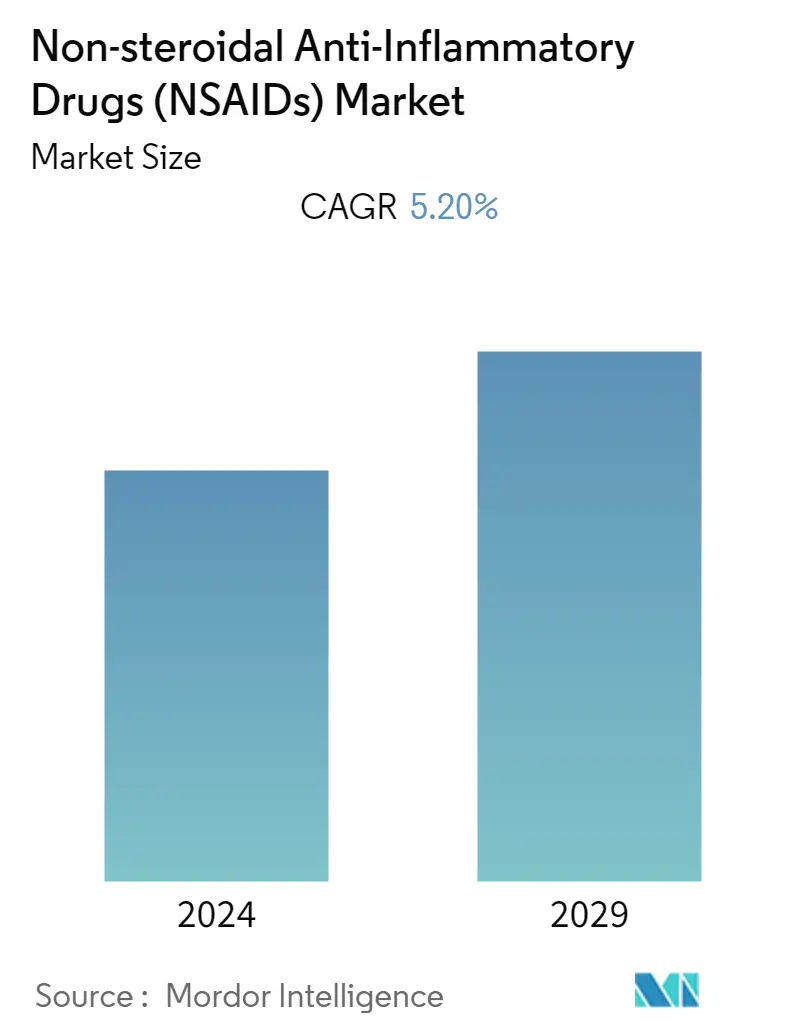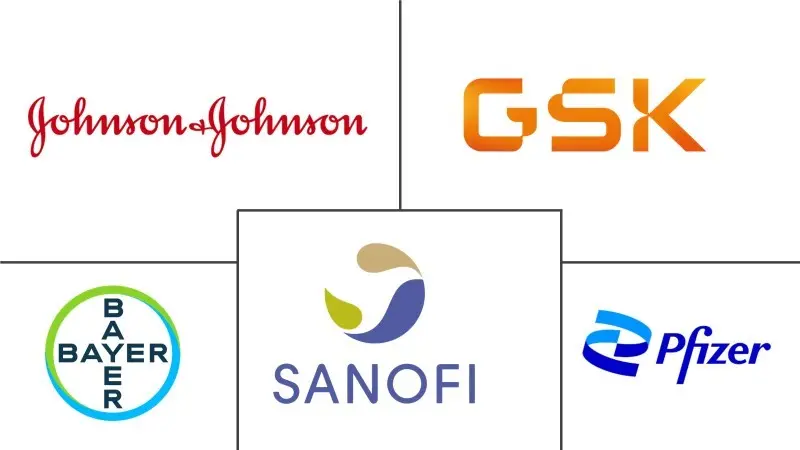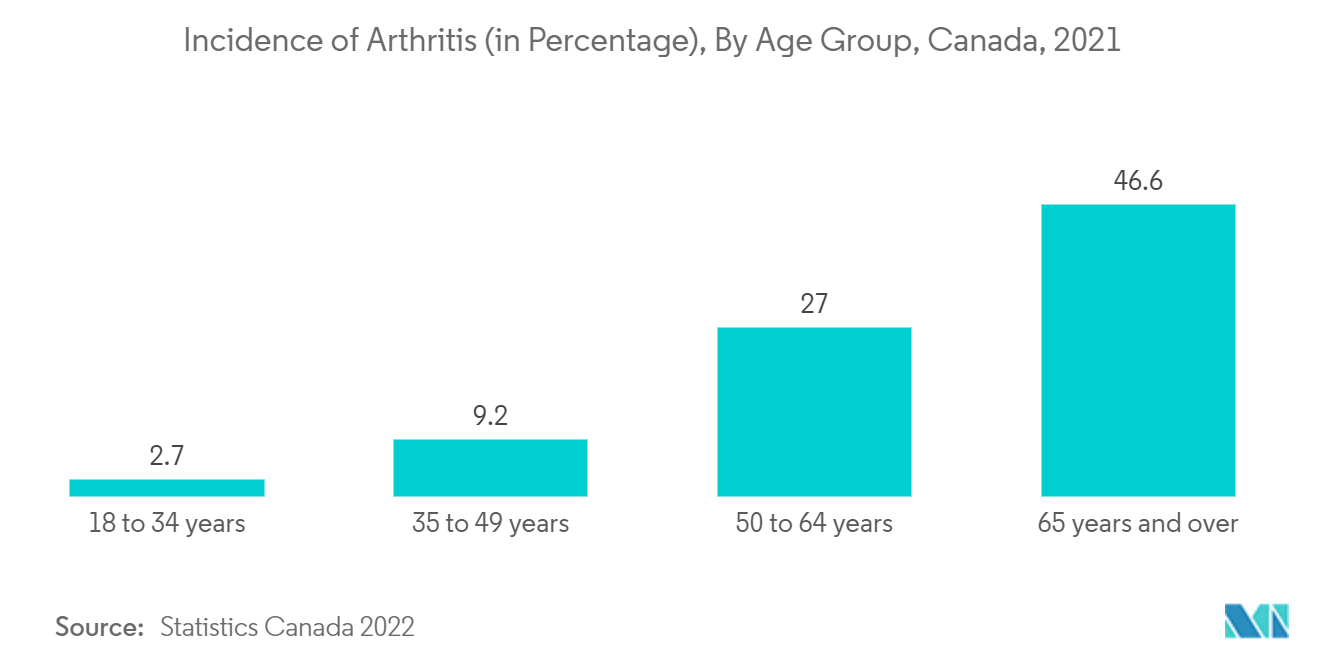Non-Steroidal Anti-Inflammatory Drugs (NSAIDs) Market Size

| Study Period | 2019 - 2029 |
| Base Year For Estimation | 2023 |
| Forecast Data Period | 2024 - 2029 |
| CAGR | 5.20 % |
| Fastest Growing Market | Asia-Pacific |
| Largest Market | North America |
Major Players
*Disclaimer: Major Players sorted in no particular order |
Non-Steroidal Anti-Inflammatory Drugs (NSAIDs) Market Analysis
The market for non-steroidal anti-inflammatory drugs (NSAIDs) is expected to register a CAGR of 5.2% over the forecast period.
- The sudden outbreak of COVID-19 led to an increase in demand for NSAIDs, as they were used to manage COVID-19 infections. NSAIDs were in high demand among infected patients to reduce pain, fever, and inflammation caused by the SARS-CoV-2 virus infection, which notably impacted the market's growth during the pandemic. The demand for NSAIDs is expected to remain intact during the post-pandemic period due to the emergence of mutant strain infections of the SARS-CoV-2 virus, which will boost the market's growth over the next five years.
- The increasing burden of chronic pain and inflammatory diseases globally is expected to boost the market's growth over the forecast period, as NSAIDs are widely used in their treatment and management. There is a high prevalence and incidence rate of migraine globally, with Australia having one of the highest rates at 28% in 2021, according to a Migraine Australia report published in May 2022. The vast usage of NSAIDs in the pain management of musculoskeletal disorders is also expected to contribute to the growth of the market.
- Musculoskeletal conditions are the leading contributor to disability worldwide, with low back pain being the single leading cause of disability in 160 countries, affecting about 1.71 billion people worldwide, according to WHO's key facts published in February 2021. In Great Britain, 470,000 people suffer from work-related musculoskeletal disorders that are new or long-standing in the year 2020-2021, according to Work-Related Musculoskeletal Disorders statistics. Therefore, the high incidence of musculoskeletal disorders is likely to lead to a growing demand for pain management drugs such as NSAIDs, contributing to the market's growth during the forecast period.
- However, the side effects caused by the use of NSAIDs are expected to restrain the market's growth during the forecast period.
Non-Steroidal Anti-Inflammatory Drugs (NSAIDs) Market Trends
The Arthritis Segment is Expected to Grow Faster and Dominate the Market Over the Forecast Period
- The increasing incidence of arthritis is predicted to accelerate the market for nonsteroidal anti-inflammatory drugs (NSAIDs), as they are commonly used in patients with chronic inflammatory arthritis. NSAIDs are effective in reducing inflammation and pain due to their ability to inhibit the biosynthesis of prostaglandins at the level of the cyclooxygenase enzyme.
- The arthritis segment is expected to hold the major share over the forecast period due to the rising prevalence of arthritis among the global population and the increasing demand for effective pain management drugs. According to the Centers for Disease Control and Prevention (CDC) data updated in October 2021, doctor-diagnosed arthritis cases in the United States are expected to reach 78.4 million adults aged 18 and over by 2040. Arthritis prevalence also increases with age.
- Severe arthritis can limit physical activity, which is directly associated with obesity, cardiovascular disease, diabetes, and other functional limitations. The older population's increased vulnerability to arthritis due to age-related decline in bone density and weak joint ligaments is also expected to contribute to segment expansion.
- There are several drugs of the NSAIDs class on the market and many more are in the pipeline to meet the growing demand for arthritis pain management, thereby contributing to the growth of the studied segment. For instance, in January 2021, the United States Food and Drug Administration (US FDA) approved a generic version of Pfizer's Celebrex (celecoxib), an oral medication used to treat inflammation and pain caused by ankylosing spondylitis and other disorders. The generic drug is also indicated to treat osteoarthritis, rheumatoid arthritis, juvenile arthritis, acute pain, and primary dysmenorrhea (pain caused by menstruation). Thus, the above-mentioned factors are expected to drive the growth of the studied segment over the forecast period.

North America is Expected to Dominate the Market and Expected to do Same Over the Forecast Period
- North America is poised to dominate the NSAIDs (non-steroidal anti-inflammatory drugs) market, holding a major share of the market throughout the forecast period. The increasing demand for effective drugs for pain relief and growing awareness among the North American population are key factors driving the growth of the market in this region.
- Chronic pain-causing disorders are prevalent among the North American population, which is expected to further drive the market. For instance, the American Migraine Foundation reported in February 2022 that nearly 39 million Americans live with migraines, and the United States Native American and Alaskan Native communities experience the highest prevalence of disabling headaches. Inflammatory diseases are also a significant burden, as per an NCBI article published in January 2021, where the age-adjusted prevalence of arthritis was 15.9% across all adults.
- Market players in North America are continuously focusing on the development of novel drugs to tackle these indications using NSAIDs. They are adopting various strategies to develop better drugs with reduced side effects, which is likely to drive the market in the region. For example, Dr. Reddy's laboratories re-launched over-the-counter Naproxen Sodium tablets of USP, 220 mg, in the United States market in August 2021. Naproxen Sodium is a non-steroidal anti-inflammatory drug used for pain relief and fever control.
- The high prevalence of arthritis in Canada is expected to contribute to the growing demand for NSAIDs for better pain management, thereby contributing to the growth of the market over the forecast period. According to the Statistics Canada data published in August 2022, the number of arthritis cases in Canada was 6,087,600 among people aged 12 years or over. This high frequency of the population suffering from arthritis is expected to contribute to the growth of the market.
- In view of these recent developments and other above-mentioned factors, the NSAIDs market is expected to get a boost in North America.

Non-Steroidal Anti-Inflammatory Drugs (NSAIDs) Industry Overview
The NSAIDs market is moderately competitive, with several players across the globe. In terms of market share, few of the major players currently dominate the market. With the increase in research and development activity, many regional players are expected to contribute to the NSAIDs market over the forecast period. Some of the key players in the market are Pfizer Inc., GlaxoSmithKline Plc, Johnson and Johnson, Bayer AG, Sanofi S.A., Horizon Therapeutics plc, Sun Pharmaceutical Industries Ltd, Iroko Pharmaceuticals Inc., Reckitt Benckiser Group PLC, Assertio Therapeutics, Inc., and others.
Non-Steroidal Anti-Inflammatory Drugs (NSAIDs) Market Leaders
-
Pfizer Inc.
-
Johnson & Johnson
-
Bayer AG
-
Sanofi S.A.
-
GlaxoSmithKline plc
*Disclaimer: Major Players sorted in no particular order
.webp)
Non-Steroidal Anti-Inflammatory Drugs (NSAIDs) Market News
- August 2022: Haleon launched Advil Plus Acetaminophen combining ibuprofen and acetaminophen, to fight pain in two ways. This is a product brought to market by Haleon since launching as an independent company focused entirely on consumer healthcare.
- May 2022: Dr. Reddy's laboratories launched the Ketorolac Tromethamine tablets USP, 10 mg, in the United States market. Ketorolac Tromethamine tablets, 10 mg, is a non-steroidal anti-inflammatory drug indicated for the short-term management of moderately severe acute pain.
Non-Steroidal Anti-Inflammatory Drugs (NSAIDs) Market Report - Table of Contents
1. INTRODUCTION
- 1.1 Study Assumptions and Market Definition
- 1.2 Scope of the Study
2. RESEARCH METHODOLOGY
3. EXECUTIVE SUMMARY
4. MARKET DYNAMICS
- 4.1 Market Overview
-
4.2 Market Drivers
- 4.2.1 Increasing Burden of Chronic Pain and Inflammation
- 4.2.2 Preference of NSAIDs over Other Class of Pain Relievers
-
4.3 Market Restraints
- 4.3.1 High Cost of Drug Development and Launches
- 4.3.2 Side Effects of NSAIDs
-
4.4 Porter's Five Forces Analysis
- 4.4.1 Threat of New Entrants
- 4.4.2 Bargaining Power of Buyers/Consumers
- 4.4.3 Bargaining Power of Suppliers
- 4.4.4 Threat of Substitute Products
- 4.4.5 Intensity of Competitive Rivalry
5. MARKET SEGMENTATION (Market Size by Value - USD million)
-
5.1 By Route of Administration
- 5.1.1 Oral
- 5.1.2 Parenteral
-
5.2 By Application
- 5.2.1 Arthritis
- 5.2.2 Migraine
- 5.2.3 Ophthalmic Diseases
- 5.2.4 Other Applications
-
5.3 By Distribution Channel
- 5.3.1 Hospital Pharmacies
- 5.3.2 Retail Pharmacies
- 5.3.3 Others Distribution Channels
-
5.4 Geography
- 5.4.1 North America
- 5.4.1.1 United States
- 5.4.1.2 Canada
- 5.4.1.3 Mexico
- 5.4.2 Europe
- 5.4.2.1 Germany
- 5.4.2.2 United Kingdom
- 5.4.2.3 France
- 5.4.2.4 Italy
- 5.4.2.5 Spain
- 5.4.2.6 Rest of Europe
- 5.4.3 Asia-Pacific
- 5.4.3.1 China
- 5.4.3.2 Japan
- 5.4.3.3 India
- 5.4.3.4 Australia
- 5.4.3.5 South Korea
- 5.4.3.6 Rest of Asia-Pacific
- 5.4.4 Middle East and Africa
- 5.4.4.1 GCC
- 5.4.4.2 South Africa
- 5.4.4.3 Rest of Middle East and Africa
- 5.4.5 South America
- 5.4.5.1 Brazil
- 5.4.5.2 Argentina
- 5.4.5.3 Rest of South America
6. COMPETITIVE LANDSCAPE
-
6.1 Company Profiles
- 6.1.1 Pfizer Inc.
- 6.1.2 GlaxoSmithKline Plc
- 6.1.3 Johnson & Johnson
- 6.1.4 Bayer AG
- 6.1.5 Sanofi S.A.
- 6.1.6 Horizon Therapeutics plc
- 6.1.7 Sun Pharmaceutical Industries Ltd
- 6.1.8 Iroko Pharmaceuticals Inc.
- 6.1.9 Reckitt Benckiser Group PLC
- 6.1.10 Assertio Therapeutics, Inc.
- 6.1.11 Zyla Life sciences
- 6.1.12 Perrigo Company
- *List Not Exhaustive
7. MARKET OPPORTUNITIES AND FUTURE TRENDS
** Subject To AvailablityNon-Steroidal Anti-Inflammatory Drugs (NSAIDs) Industry Segmentation
As per the report's scope, Nonsteroidal anti-inflammatory drugs (NSAIDs) refer to a group of a drug class that reduces pain, decreases fever, prevents blood clots, and decreases inflammation in higher doses. NSAIDs block enzymes in the body that produces prostaglandins. Prostaglandins are a group of naturally occurring fatty acids that play a role in pain and inflammation.
The non-steroidal anti-inflammatory drugs (NSAIDS) market is segmented by route of administration (oral and parenteral), by application (arthritis, migraine, ophthalmic diseases, and other applications), by distribution channel (hospital pharmacies, retail pharmacies, and other distribution channels), and geography (North America, Europe, Asia-Pacific, Middle East and Africa, and South America). The market report also covers the estimated market sizes and trends for 17 different countries across major regions globally.
The report offers the value (in USD million) for the above segments.
| By Route of Administration | Oral | |
| Parenteral | ||
| By Application | Arthritis | |
| Migraine | ||
| Ophthalmic Diseases | ||
| Other Applications | ||
| By Distribution Channel | Hospital Pharmacies | |
| Retail Pharmacies | ||
| Others Distribution Channels | ||
| Geography | North America | United States |
| Canada | ||
| Mexico | ||
| Geography | Europe | Germany |
| United Kingdom | ||
| France | ||
| Italy | ||
| Spain | ||
| Rest of Europe | ||
| Geography | Asia-Pacific | China |
| Japan | ||
| India | ||
| Australia | ||
| South Korea | ||
| Rest of Asia-Pacific | ||
| Geography | Middle East and Africa | GCC |
| South Africa | ||
| Rest of Middle East and Africa | ||
| Geography | South America | Brazil |
| Argentina | ||
| Rest of South America |
Non-Steroidal Anti-Inflammatory Drugs (NSAIDs) Market Research FAQs
What is the current Non-steroidal Anti-Inflammatory Drugs (NSAIDs) Market size?
The Non-steroidal Anti-Inflammatory Drugs (NSAIDs) Market is projected to register a CAGR of 5.20% during the forecast period (2024-2029)
Who are the key players in Non-steroidal Anti-Inflammatory Drugs (NSAIDs) Market?
Pfizer Inc. , Johnson & Johnson , Bayer AG, Sanofi S.A. and GlaxoSmithKline plc are the major companies operating in the Non-steroidal Anti-Inflammatory Drugs (NSAIDs) Market.
Which is the fastest growing region in Non-steroidal Anti-Inflammatory Drugs (NSAIDs) Market?
Asia-Pacific is estimated to grow at the highest CAGR over the forecast period (2024-2029).
Which region has the biggest share in Non-steroidal Anti-Inflammatory Drugs (NSAIDs) Market?
In 2024, the North America accounts for the largest market share in Non-steroidal Anti-Inflammatory Drugs (NSAIDs) Market.
What years does this Non-steroidal Anti-Inflammatory Drugs (NSAIDs) Market cover?
The report covers the Non-steroidal Anti-Inflammatory Drugs (NSAIDs) Market historical market size for years: 2019, 2020, 2021, 2022 and 2023. The report also forecasts the Non-steroidal Anti-Inflammatory Drugs (NSAIDs) Market size for years: 2024, 2025, 2026, 2027, 2028 and 2029.
NSAIDs Industry Report
Statistics for the 2024 NSAIDs market share, size and revenue growth rate, created by Mordor Intelligence™ Industry Reports. NSAIDs analysis includes a market forecast outlook to 2029 and historical overview. Get a sample of this industry analysis as a free report PDF download.



